The other main housing rent-seeker, the Housing Industry Assocation (HIA), has emerged to lobby against changes to negative gearing, claiming once more that any such move would trash housing investment, force-up rents and prices, and destroy wealth creation.
Below is the HIA’s media release combined with facts exposing their lies.
The Housing Industry Association (HIA) has expressed concern at reports that changes to negative gearing might be back on the table, as the government investigates alternative taxation reform options to the GST.
“New housing is one of the most highly taxed sectors in the economy, and the removal of negative gearing would only make that situation worse and discourage investment,” according to HIA Chief Executive Industry Policy and Media Graham Wolfe.
Research conducted by Independent Economics on behalf of the Housing Industry Association (HIA) confirmed that restricting access to negative gearing for residential property would reduce investment in housing, erode housing affordability and put upward pressure on rents.
“Negative gearing promotes private investment in the rental market, both stimulating economic activity and taking the pressure off social housing and the public purse.”
The HIA’s arguments would make some sense if negative gearing was, in fact, being used to stimulate housing supply, rather than merely bidding-up the price of existing homes.
Unfortunately for the HIA, the ABS’ housing finance data shows emphatically that this is not the case. As shown in the next chart, while investment in existing dwellings has literally exploded since negative gearing was reinstated in 1987, investment in new construction – which adds to housing supply – has been poor (see next chart).
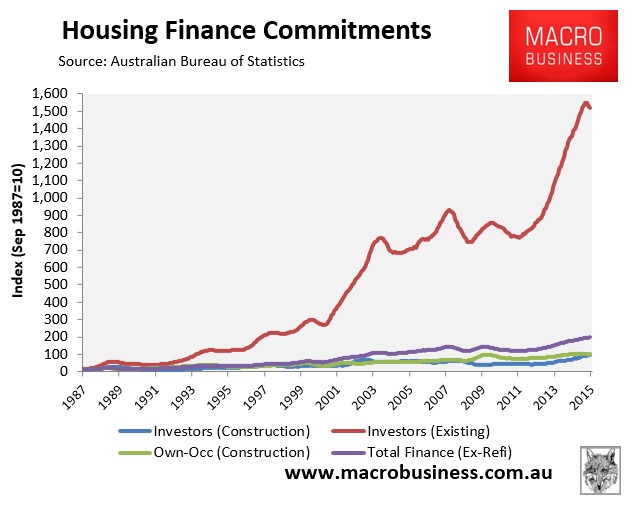
In fact, investment in new construction has been so poor that it has actually grown at a slower rate than owner-occupied construction lending since negative gearing was reinstated in 1987 (see next chart).
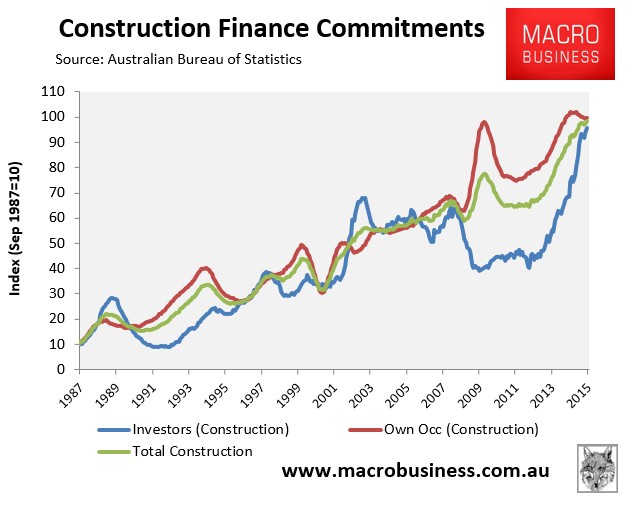
Given every other form of finance has grown stronger since negative gearing was reinstated in 1987, negative gearing has clearly done nothing to boost housing supply, and instead has merely substituted homes for sale into homes for let. Accordingly, negative gearing has not improved rental availability or affordability, and has merely boosted demand and put upward pressure on existing home prices.
Therefore, the HIA’s claims are categorically false. The only “investment” that would be affected by curbing negative gearing is speculative investment into existing dwellings, not genuine investment in new construction. And because of this, there would be an improvement in housing affordability without adversely affecting rents.
Back to the HIA:
“With an ageing workforce and future pressure expected on publicly funded services, policy settings such as negative gearing that promote wealth creation and self-sufficiency in retirement should be promoted.”
This claim is not credible when an economy-wide view is taken.
As shown above, all negative gearing has done is used taxpayer subsidies to push-up house prices and turned would-be home owners into renters – hardly a desirable outcome from a budgetary or social perspective and hardly a recipe for “self-sufficiency in retirement”.
Clearly, the HIA does not care about the financial security of young Australians who are being locked-out of the housing market due in part to the orgy of investor participation (see next chart), or are being forced to undergo a lifetime of debt servitude?
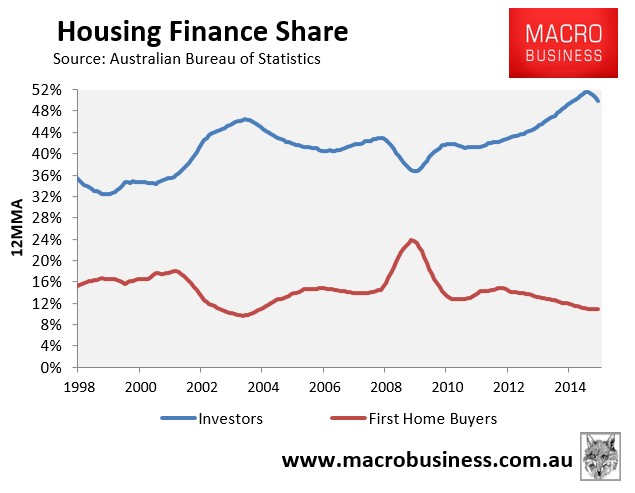
If negative gearing was unwound, there would be less pressure on house prices and younger Australians would not need to devote as much of their lifetime’s earnings to pay-off a home.
Surely, the financial situation of ordinary Australians would be improved materially if they were not required to pay-off some of the world’s biggest mortgages, due in part to egregious policies like negative gearing?
Back to the HIA:
“It is important to remember that negative gearing is not the domain of so-called ‘wealthy investors’.”
“Figures from the ATO demonstrate that 79% of tax payers with a rental property declare a taxable income of less than $100,000.”
“In fact, seven out of ten tax payers with a rental property earn less than $80,000.”
Negative gearing is used predominantly by higher income earners. The facts are clear.
The ATO figures that the HIA has quoted are “taxable income”, which is what is left after legitimate deductions such as negative gearing are accounted for. For example, if someone earning $89,000 a year in 2012-13 claimed the average negative gearing loss of $9,558 that year, then their taxable income would be reduced to $79,442, thus making them appear to be a lower income earner than they actually were, and bringing them within the arbitrary $80,000 threshold.
Moreover, the average taxable income in 2012-13 was only $55,228. Therefore, the HIA’s $100,000 threshold quoted above is nearly twice the average income – a bonafide high income earner. The $80,000 is nearly 50% above the average taxable income level – therefore a higher income earner.
If it was true that so-called middle Australians were the primary users of negative gearing, then we would expect to see half of the users earn less than the average.
However, the ATO statistics clearly show that 55% of negatively geared investors in 2012-13 earned above the average taxable income level (see next chart).
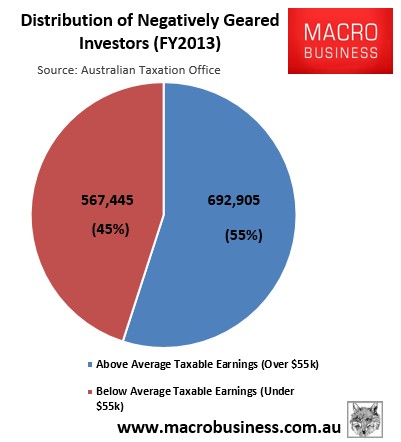
Worse, the distribution of negative geared losses is even more skewed towards higher income earners (see next chart).
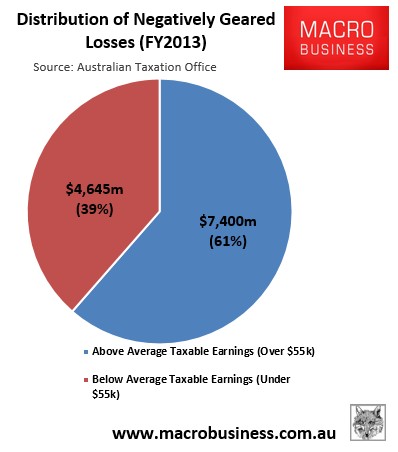
So, based purely on the ATO statistics, which understate the magnitude of the issue because negative gearing lowers taxable income, the oft-used claim that most people who access negative gearing are middle-income Australians is false. 55% reported earnings above the average taxable income in 2012-13, with their share of losses at 61%, even after their reportable incomes were reduced by more than the average due to negative gearing deductions.
The HIA’s argument makes even less sense when broader measures of household income, not “taxable income”, are taken into account.
According to the RBA, based on data from the Household, Income and Labour Dynamics in Australia (HILDA) Survey, households in the top two income quintiles hold nearly 80% of all investor housing debt (see next chart).
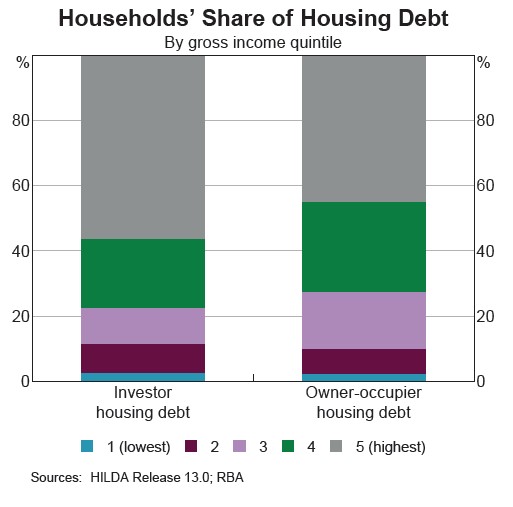
And according to the ABS’ latest housing occupancy and cost data, the richest 20% of households accounted for 39% of all housing investors (chart via Greg Jericho):
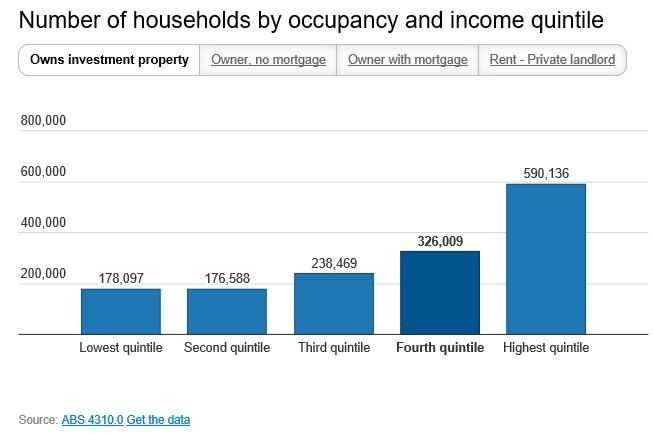
Finally, modelling from the National Centre for Social and Economic Modelling (NATSEM) revealed that one third (34.1%) of the benefits of negative gearing were captured by the top 10% of income earners, whereas 15.7% of negative gearing benefits goes to the next 10% of income earners (see next chart).
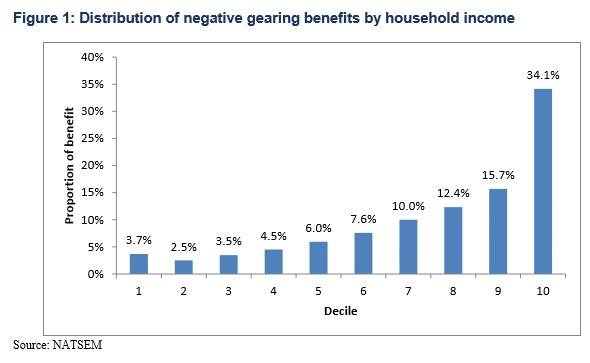
So that’s the top 20% of income earners receiving around half of the negative gearing benefits, according to NATSEM.
However you cut it, the HIA’s position is false. Negative gearing is the domain of wealthier Australians.
Back to the HIA:
“A body of independent research has been developed over a number of years that demonstrates categorially that negative gearing is a positive force for the Australian economy,” concluded Mr Wolfe.
The only “body of research” comes from paid consultants to the property lobby, along with other industry mouth pieces. Any genuine analysis of the data shows negative gearing to be a giant waste of taxpayer money that merely inflates house costs and reduces equity and efficiency for no public benefit.

